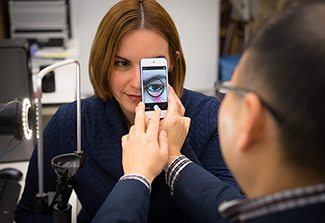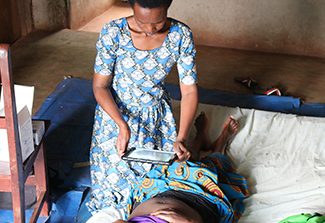Fogarty-funded projects receive NIH technology awards
March/April 2024 | Volume 23 Number 2
By Mariah Felipe
 Photo courtesy of Purdue University/Vincent Walter
Young Kim (in foreground with his back to the camera) takes a photo using a smartphone of the inner eyelid of study participant.
Photo courtesy of Purdue University/Vincent Walter
Young Kim (in foreground with his back to the camera) takes a photo using a smartphone of the inner eyelid of study participant.
In the last four years, two Fogarty
Mobile Health (mHealth) program grant recipients have received first-place NIH NTAC awards.
The NIH Technology Accelerator Challenge (NTAC), launched by the National Institute of Biomedical Imaging and Bioengineering (NIBIB) in 2020, is a series of prize competitions created to stimulate the design of new diagnostic technologies and accelerate the full development of those products for use in low-resource settings.
Detecting blood disorders with a photograph
Dr. Young Kim, professor of biomedical engineering at Purdue University, received a NTAC award in 2020 for his team’s
Fogarty-funded project that led to the development of a smartphone application with the ability to detect anemia and sickle cell disease by extracting information about the state of microvasculature and blood hemoglobin from a photo of a patient’s inner eyelid. The algorithm mimics a spectroscope analysis, which detects how hemoglobin absorbs light.
The algorithm was developed over the course of three years through a collaboration with the Moi Teaching and Referral Hospital via the Academic Model Providing Access to Healthcare (AMPATH) program in Kenya. The NTAC award led to the development of
HemaChrome a startup supported by Purdue, which focuses on bringing the technology back to the U.S. for digital health and telemedicine.
Kim has received additional funding from NIBIB to use machine learning (ML) to assist in spectral recovery, restoring color and light to conventional photos, with a focus on maternal health applications in Kenya.
The CDC and and Kim’s team will soon start a trial using ML photo analysis and mHealth applications to detect fluorosis (overexposure to fluoride) and cavities in the teeth of adolescents. “A photograph is more than merely a picture; it contains detailed spectral information" that can be used by mHealth applications.
"The initial support from Fogarty triggered a chain reaction of research and I'm so grateful for the ample opportunities that ultimately came from that," say Kim who is also a principal investigator on a Fogarty-funded project using ML-based mHealth technology
to prescreen for malaria among school-age children in Rwanda. If the prescreening tool is successful in this setting, it could provide significant cost savings on mass screening for malaria.
 Photo courtesy of Harvard University/Matt HedtA community health worker in Rwanda uses the app designed by Bethany Hedt-Gauthier, Fredrick Kateera and team to assess a post-cesarean surgical wound.
Photo courtesy of Harvard University/Matt HedtA community health worker in Rwanda uses the app designed by Bethany Hedt-Gauthier, Fredrick Kateera and team to assess a post-cesarean surgical wound.
Using AI to prevent risks after cesarean delivery in Rwanda
In 2022, a team led by Dr. Bethany Hedt-Gauthier, associate professor of global health and social medicine at Harvard University and associate professor in the department of biostatistics at Harvard T.H. Chan School of Public Health, and Dr. Fredrick Kateera, deputy executive director of Partners In Health and lecturer at the University of Global Health Equity, Rwanda, won the
NTAC Maternal Health award for their Fogarty-funded project.
Since 2016, the team has worked to develop a stand-alone mHealth application for community health workers to monitor postpartum recovery of women who had a cesarean delivery. The tool, recently featured in
Science, allows community health workers to provide new mothers with a home-based diagnosis of surgical-site infections alongside general postpartum monitoring. The app uses computer-vision techniques and AI to detect signs of infection in the photographs of surgical wounds. The team has focused on rural regions of Rwanda, and their machine learning-based algorithms have achieved nearly 90% accuracy in diagnosing infections. The check-ins, completed within 10 days of childbirth, allow for community health workers to refer the mothers to a hospital if an infection or other cesarean-related complications are detected.
The NTAC award has allowed researchers to continue assisting team members with costs for training and educational opportunities and to flexibly pursue changes needed to scale the application in Rwanda and beyond. Changes include updating the data used to build the AI models, obtaining more modern cameras for better data quality, and getting more data to expand the use cases of their applications beyond cesarean-related surgical infections. Hedt-Gauthier says “Systems are constantly updating and getting better, so it’s been a learning process for us to understand how we keep up with the pace of that growth.”
Both Kateera and Hedt-Gauthier agree that working in Rwanda over the years has opened their eyes to major gaps in postnatal care, in all settings. The NTAC award has been a great motivation for the team and, as Kateera says, “it has allowed people to grow and work together around optimizing outcomes for new mothers.”
More Information
Updated April 12, 2024
To view Adobe PDF files,
download current, free accessible plug-ins from Adobe's website.
Related Fogarty Programs
Related World Regions / Countries
Related Global Health Research Topics